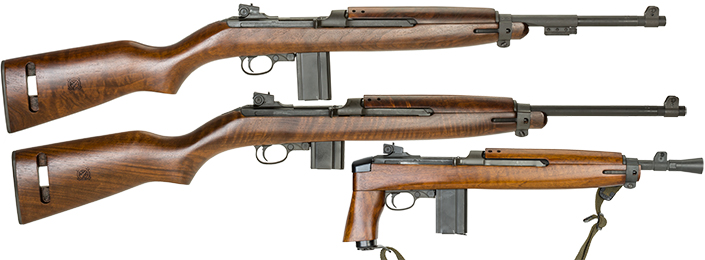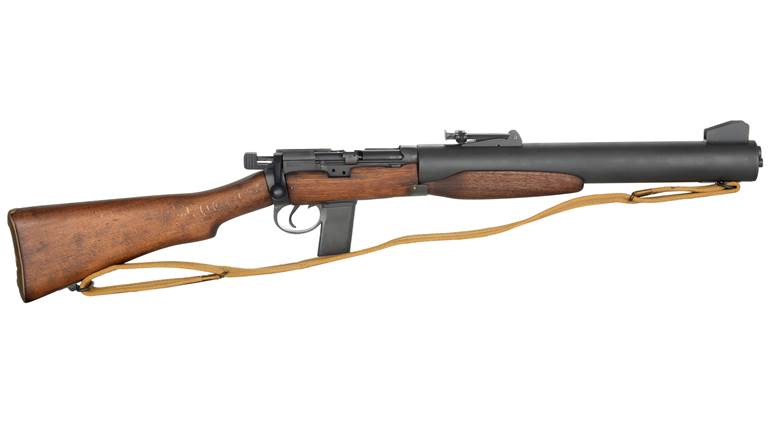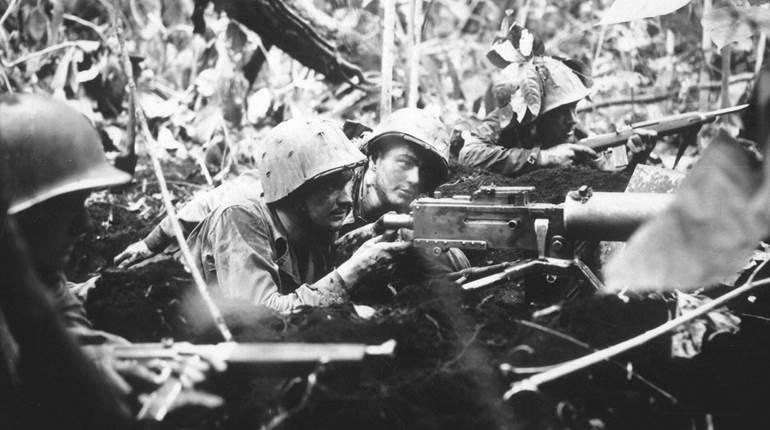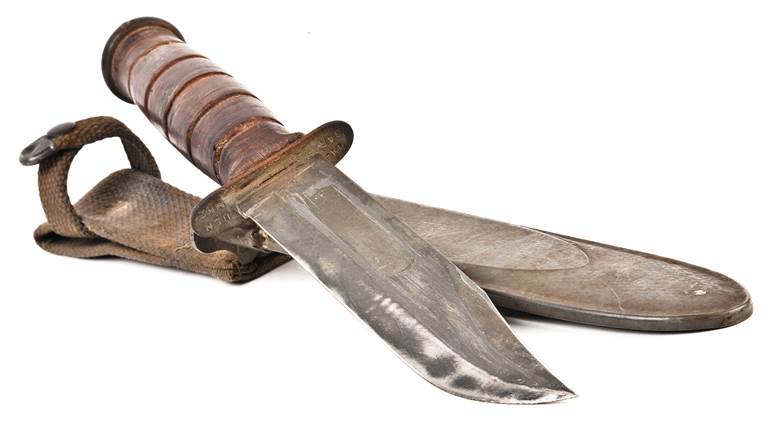
Long decades have passed since the M1 carbine was removed from military service, but the years have done little to diminish the popularity of the diminutive rifle. Today, thanks to a variety of factors, the “Light Rifle” still enjoys one of the broadest fan bases in the gun world—and in many ways a high-quality, modern reproduction is just as appealing as a wartime relic.
For one, it is easy for virtually anyone to use. Short, light, well-balanced, soft-recoiling and fast-firing, it is a joy to shoot for even the small-statured and recoil-averse. Secondly, due to its unique production history, with numerous manufacturers making countless iterations of the same model, the M1 carbine is a gun collector’s dream. But ask a collector if you can take a few shots through one of his mint prized pieces, and his eyes will likely go wide with trepidation. On the other hand, a replica that looks, handles and shoots as well, if not better, than the original provides the same experience without the risk of anything unpleasant happening to diminish the value of a cherished heirloom. Nostalgia also plays a role in the continued popularity of the platform, as veterans, and their family members, are often keen to own a high-functioning facsimile of the arm they (or a loved one) once carried into war.

With total production exceeding 6.5 million units, the M1 carbine was the most prolifically manufactured American small arm of World War II, and no firm produced more than the Inland Manufacturing Division of General Motors. But while the original Inland left the firearm industry nearly 70 years ago at war’s end—and indeed has since ceased to exist altogether—in recent years a new company has sprung up to resurrect the tradition of producing American-made M1 carbines bearing the Inland name. Precisely reproduced from the original specifications, and built using 100 percent domestically sourced parts, today’s Inland offers a full line of carbines that look and feel just as good as the genuine article—and, in most cases, shoot even better.
The “U.S. Carbine, .30 Caliber, M1,” much more commonly known as the M1 carbine, was created in response to a U.S. Army requirement for a “Light Rifle” to augment the standard-issue M1 Garands already in service. Primarily intended for use by rear-echelon troops who, until that time, had either been unarmed or carried only a sidearm, the carbine was also issued to specialized frontline troops—such as signal corps personnel and crew-served weapon operators—who were likely too encumbered with their own equipment to also wield the sizeable Garand service rifle. Many gunmakers provided entrants for the government trials; however, it was the Winchester design—that company having already developed the Light Rifle project’s rimless, .30-cal. cartridge, the .30 Carbine—that received the unanimous support of the Ordnance committee. Initially only two companies were contracted to produce the new rifles, Winchester and Inland. It quickly became apparent that demand would far outpace supply, and eight other facilities (including incongruous choices such as IBM, National Postal Meter and Rock-Ola) would eventually tool up to build M1 carbines, as well.
The Inland Manufacturing Division of General Motors had been created in October 1922 to manufacture car steering wheels, but by the start of World War II had expanded its operations to fabricate more than 1,300 products for planes, trains, automobiles, washing machines and refrigerators. Operating out of Dayton, Ohio, in the very hangers that once housed Orville and Wilbur Wright’s defunct Wright Airplane Co. (explaining the company’s hanger-shaped logo), Inland was already churning out war matériel—such as plastic helmet liners, anti-aircraft gun sights and tank tracks—prior to its involvement with the M1 carbine.

The first production run of M1 carbines left the Inland plant in early 1942, and production would continue until V-J Day (Aug. 15, 1945). Originally, Inland was to ship 22,000 carbines per month, but by the end of the war that figure had increased to an incredible 90,000 units a month. Later in 1942, a wire-stocked variant of the carbine, the M1A1, was created and adopted by the military, and Inland was the exclusive manufacturer of the paratrooper-friendly carbines. Inland’s engineering department was also responsible for the development of the M2 carbine and the FP-45 Liberator pistol (which was subsequently produced by GM’s Guide Lamp Division). All told, during a three-year period, Inland produced a total of 2,625,591 M1 carbines—single-handedly responsible for roughly 40 percent of the total supply.
The M1 carbine would go on to see combat in both Korea and Vietnam, remaining in service long after many of its contemporaries had been forced into retirement. At the conclusion of World War II, Inland returned to automotive manufacturing, and in 1989 merged with other GM properties and was eventually spun off from the parent company in 1999. This would have been the end of the Inland story, were it not for veteran, former U.S. Army Marksmanship Unit member and firearm developer Ron Norton, who founded Inland Mfg., LLC, a few years ago and set up shop just two short miles from where the original GM plant stood.
The city of Dayton has always taken great pride in its historic ties to the old Inland plant, and as a Dayton native himself, Norton had grown up with a special appreciation for the M1 carbines produced there. So when he left Chiappa Firearms, Ltd., in 2013 to pursue a different venture within the firearm industry, the transition to producing high-quality, historically accurate reproductions of Inland’s M1s not only came naturally to Norton; it was a project close to his heart. At the time of this writing, Inland’s product line stood at four M1 carbine-based models—three rifles (M1 1944, M1 1945 and M1A1) and the Advisor handgun—however several new models were introduced at SHOT Show 2016. For more information regarding these recent additions, visit americanrifleman.org/inland2016.
Throughout its production life, the M1 carbine continually evolved, as upgrades and design modifications through the years led to alterations to numerous component parts—including the wood stock, trigger housing, extractor, recoil plate, magazines and safety, among others—as well as changes in barrel steel and annealing methods. This constant progression is reflected in Inland’s catalog of M1s, which all share the same “guts,” yet vary in terms of furniture, features and accessories.
Like their storied forebear, Inland’s new M1 carbine models rely on a short-stroke-gas-piston system in order to cycle. Gas siphoned from the barrel pushes a tappet-style piston back roughly 1/3" to strike the operating slide, which, during its rearward movement, cams a rotating bolt to unlock the action and extract the spent case. Following ejection of the case, the recoil-spring assembly then returns the operating slide forward again, causing the bolt to strip a fresh cartridge from the detachable box magazine and chamber it prior to locking into the receiver. The bolt can be locked back using a pin located on top of the slide. To activate, just pull the slide back fully and then depress the pin until it nests within an indentation in the upper surface of the receiver.

The new carbines are produced using both steel components and stocks that meet the original G.I. specifications, meaning that parts for the new guns will interchange with those assembled during the war. Built on investment cast receivers, most of the metal parts on the new guns bear a Parkerized finish, and the included staggered-column magazine has been blued. Although the stocks are made of somewhat plain-figured walnut, this actually adds to the authenticity of these replicas, as high-grade wood was understandably not a priority on World War II-era carbines.
The catalog’s two full-stocked rifles bear an Ordnance crossed cannons stamp on the right side of the buttstock, while the mark is located under the pistol grip on the M1A1 and Advisor models. The barrels of all four models are marked “INLAND MFG DAYTON, OHIO” just rear of the front sight. All four Inland M1 carbines are also marked “U.S. CARBINE, CAL 30 M1” atop the front of the receiver, and “INLAND MFG” at its rear.
The product line’s three long guns all feature 18" barrels with four-groove rifling and a 1:20" right-hand twist, and the Advisor only differs in its truncated 12" barrel and lack of buttstock. Front sights for all models are a fixed post with a protective wing on each side, and the aperture rear sights are adjustable for both windage and elevation. The sights are mounted very low to the bore’s axis, with a trough cut into the upper handguard being necessary for a sight picture to be achieved. All of Inland’s M1 carbine models feature stocks of the “low wood” variety, meaning that extra wood in the vicinity of the operating slide has been trimmed away in order to increase clearance and facilitate smoother cycling of the rifle. Carbines produced early in the war did not have near as large a recess in which the slide could reciprocate, and today are referred to as “high wood” guns.

Magazines are fed into the firearms via a magazine well located forward of the trigger guard. A push-button magazine release is located on the right side of the receiver, and ejected magazines fall free of the gun without manual assistance. The magazine well also contains a support arm that allows the use of bulkier, 30-round magazines in the guns.
Located between the trigger guard and the magazine release is the gun’s crossbolt, push-button safety. Although it operates in a manner similar to most modern safeties of the same type, with the button pushed to the right for “safe” and to the left for “fire,” it does not feature a red ring when in the “fire” position that most such safeties have today. Early examples of wartime M1 carbines employed a push-button safety similar to the ones used on the new Inland’s rifles, however, because they functioned similarly, and were similarly located to the guns’ magazine releases, reports started coming in of soldiers attempting to switch off their gun’s safety under duress and instead dropping their magazine. To address this potentially disastrous issue, the safety on later World War II-era carbines was changed to a flip-lever design (as seen on the original M1A1 on p. 88), and anyone interested in installing a flip safety on any of Inland’s guns can do so without additional alterations.
As can be inferred from the model designation, the new Inland’s M1 1944 is so named because it faithfully replicates the carbines that the original company was churning out during 1944, and this model is the most simply adorned of the company’s rifles. However, this simplicity comes with a major benefit—featuring a Type 2 barrel band, lacking a bayonet lug and shipping with a 10-round magazine (the company’s other offerings all come with 15-round magazines), the M1 1944 is legal for purchase even in some states with restrictive magazine and bayonet lug laws such as California and New York.
With the exception of the aforementioned bayonet lug and the standard-capacity, historically accurate 15-round magazine, the M1 1945 is in all other ways identical to the ’44. The M1 carbine was not adapted to mount a bayonet until the latter days of the war. The gun measures just 35.75" long and weighs a slight 5 lbs., 3 ozs. The buttstock contains a cutout for housing an oiler and attaching a sling (both of which are included with all the various M1 models), and the front sling attachment point is located on the left side of the rifle’s barrel band.

The M1A1 was the only gun during World War II specifically made for use by U.S. Army Airborne Forces, and the replica of this Inland-exclusive rifle is every bit as compact and portable. Featuring a left-side-folding wire stock and a pistol grip, the carbine measures the same length as its wood-stocked brethren when extended (35.75"), and a full 10" shorter (25.75") when folded, and weighs in at 5 lbs., 3 ozs. Installed midway along the top of the steel stock is a leather cheek pad that makes acquiring a sight picture and firing the wire-stocked gun a much more pleasant experience. Inland’s M1A1 is not furnished with a bayonet lug, and its sling is attached to the rear of the gun via a metal loop affixed to the bottom of the pistol grip.
A favorite practice among many military advisors during Vietnam, as well as tunnel rats and Special Operations Groups that had need of a close-quarters defensive firearm, was to cut down an M1 carbine and convert it into a handgun. Both full-stocked carbines and M1A1s were adapted in this way, with the paratrooper models being much preferred but harder to come by, which is why the new Inland chose to alter its own M1A1 when designing the aptly named Advisor pistol. Essentially an M1A1 without the wire buttstock, the Advisor’s barrel has also been reduced to 12", and an era-correct bell-shaped flash hider has been affixed to the end. The abbreviated barrel and missing buttstock give the Advisor an overall length of 21" and a heft of 4 lbs., 9 ozs. It is assembled by the manufacturer as a pistol, however, should an NFA collector desire to legally build a short-barreled M1 carbine for himself, the components needed to do so are available from Inland.
Complaints of marginal accuracy have long dogged wartime M1 carbines; some will shoot better and others worse, but 4-minute-of-angle accuracy is a more-than-fair approximation of what the World War II rifles were capable of. Citing precision-bored barrels, more consistent bedding of the actions to the stocks and tighter tolerances throughout the guns, Inland claims its new-production rifles are considerably more accurate than the originals—with some samples purported to even manage 1- to 2-m.o.a. groups at 100 yds. While the accuracy testing we conducted with a factory-supplied M1 1945 did not approach those levels of precision, our results were certainly an improvement compared to what could be expected from the average 70-year-old war remnant. Initially we did experience a number of stoppages, however, they were quickly diagnosed as being magazine-induced, and we encountered no further issues after swapping out magazines.

In addition to the reasons listed above, since opening shop, Norton has discovered another, unforeseen yet welcome, factor contributing to the modern-day popularity of the M1 carbine—its frequent inclusion in video games. With countless combat-themed video games available on the market, he said it is not at all uncommon for him to encounter a young person who is obviously well-acquainted with the M1 carbine platform, but who will confess to him that he or she has never gotten to actually handle a real one.
It is because of this unflagging popularity across a broad range of demographics, however, that prices of original M1 carbines have continued to rise. While well-worn, more commonly produced examples could be had at gun shows as recently as five years ago for as little as $500, today these same models tend to start in the $800 range and go up from there—and may still be of dubious shootability. Meanwhile, superb-condition carbines in desirable configurations, such as the M1A1, can fetch premium price tags approaching $4,000. In a market such as this, opting instead to purchase a new-production Inland carbine, none of which retail for more than $1,200, makes a lot of sense.
After having the opportunity to extensively handle and fire several new-production Inland M1 carbines, it is apparent to me that the workers producing them have a thorough understanding of, and deep appreciation for, both the rifle’s design and the enduring legacy of the original company—and that’s exactly the kind of people I want to have reproducing such a historically vital gun.

 Inland M1911s?
Inland M1911s?The Inland Division of General Motors never got into the business of producing M1911s during World War II to assist in the war effort, although the company actually did produce a concept M1911 made from metal stampings during the war. But the pistol was never put into production due to it being larger and heavier than the standard M1911A1. The “new” Inland (Inland Mfg., LLC), however, offers two models for fans of John Moses Browning’s masterpiece. Both guns are chambered in .45 ACP and are 100 percent made in America, featuring 5" barrels and feeding from seven-round, detachable-box magazines.
Inland founder Ron Norton calls his company’s M1911 A1 Government “the M1911 that Inland ‘could’ have built.” An accurate reproduction of the World War II-era pistol, the A1 Government (MSRP $749) wears a Parkerized finish and has an empty weight of 39 ozs. Meanwhile, the M1911 Custom Carry (MSRP $995) sports a stainless steel finish and features numerous modern refinements to the M1911 platform—including Novak-style sights, an extended beavertail, skeletonized hammer and trigger, front cocking serrations, and texturing on the frontstrap and mainspring housing. Inland offers Custom Shop options to its line of M1911 pistols, and also plans to introduce new handgun models to its line in the future.
A New Generation Of .30 Carbine
While the M1 carbine has earned many fans during the past seven decades, it has also accumulated a few detractors, as well, and much of that acrimony stems more from the cartridge it fires than from the firearm itself. Carried by our troops concurrently with the M1 Garand, the M1 carbine is sometimes hurt by unfair comparison to its bigger, older brother—as the .30 Carbine cartridge of the latter doesn’t come close to matching the power of the .30-’06 Sprg. of the former, nor was it ever intended to do so.
 Over time, the .30 Carbine’s original military loading, a 110-gr. full-metal-jacketed projectile propelled at 1900 f.p.s., developed a reputation with some of our troops for being inadequate to the task of effectively stopping advancing enemy forces. But the civilian market is not limited to non-expanding projectiles in the same way that Uncle Sam was, and during the intervening years several ammunition manufacturers have started producing loads utilizing more advanced bullet designs and faster velocities that considerably increase the .30 Carbine’s potential as a self-defense and hunting cartridge. Below are a few options available on the market today for those shooters who desire to put their M1 carbines to uses other than simply plinking and target shooting.
Over time, the .30 Carbine’s original military loading, a 110-gr. full-metal-jacketed projectile propelled at 1900 f.p.s., developed a reputation with some of our troops for being inadequate to the task of effectively stopping advancing enemy forces. But the civilian market is not limited to non-expanding projectiles in the same way that Uncle Sam was, and during the intervening years several ammunition manufacturers have started producing loads utilizing more advanced bullet designs and faster velocities that considerably increase the .30 Carbine’s potential as a self-defense and hunting cartridge. Below are a few options available on the market today for those shooters who desire to put their M1 carbines to uses other than simply plinking and target shooting.
Cor-Bon is the exception in modern .30 Carbine options, most of which retain the 110-gr. bullet weight of the military ball load. Its DPX offering, topped with an expanding, solid-copper bullet, instead pushes a 100-gr. projectile to 2025 f.p.s. and 910 ft.-lbs. of energy.
Federal Premium offers two .30 Carbine choices, both achieving what has seemingly become the industry standard for the cartridge—1990 f.p.s. and 967 ft.-lbs. of energy: an American Eagle FMJ load and a Power-Shok Soft-Point Round-Nose. Federal markets the Power-Shok as being intended for use on varmints, predators and small game at short range.
Hornady has three .30 Carbine loads, two of which feature expanding projectiles: an FMJ, a Round-Nose and a Critical Defense load topped with an FTX bullet. Each is loaded a little hotter than most of the competition—reaching 2000 f.p.s. and 977 ft.-lbs. of energy.
Magtech offers an FMJ load and a Soft-Point hunting load in .30 Carbine that attain 1990 f.p.s. and 967 ft.-lbs. of energy. For hunting purposes, the Soft-Point offering maintains 602 ft.-lbs. of energy at 100 yds., and 433 ft.-lbs. at 200 yds.
Prvi Partizan offers an FMJ and a Soft-Point Round-Nose. The SP-RN load reaches 1990 f.p.s. and 967 ft.-lbs. of energy, and, when zeroed at 100 yds., drops 12.7" at 200 yds.
Remington produces two .30 Carbine loads, a fully jacketed UMC load for practice and a Soft-Point load for small game hunting. Like many of its competitors, both leave the muzzle at 1990 f.p.s. and 967 ft.-lbs. of energy.
Winchester has two loads for the .30 Carbine: a non-expanding FMJ and a Super-X load that provides rapid, controlled expansion for use against small prey. Each option is loaded to 1990 f.p.s. and 967 ft.-lbs. of energy at the muzzle.
In addition to these expanding loads, more manufacturers are currently producing FMJ .30 Carbine ammunition than ever before. Ammunition makers that offer ball .30 Carbine loads (in addition to the ones listed above) include: Aguila, Armscor, Sellier & Bellot and Tula.






































